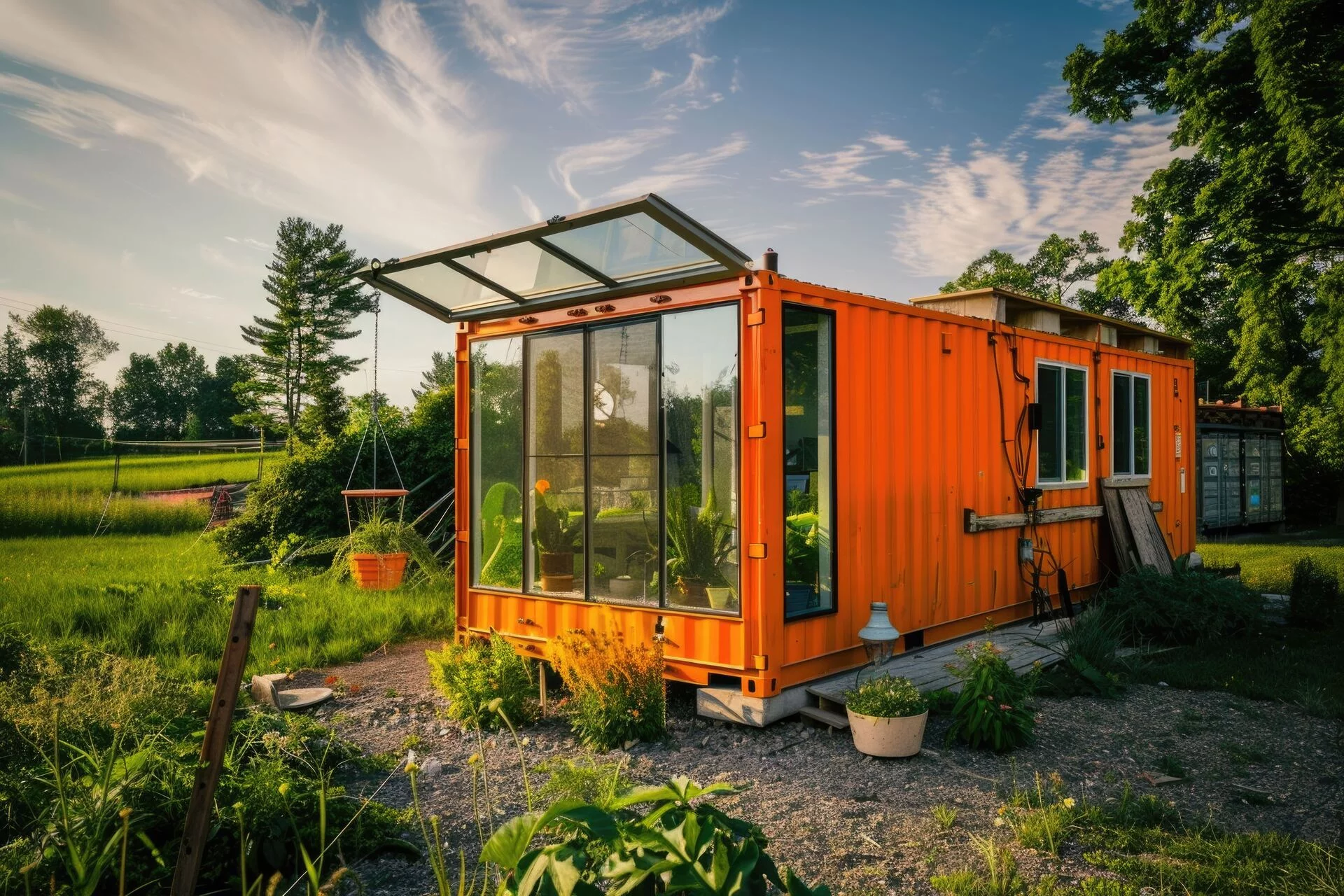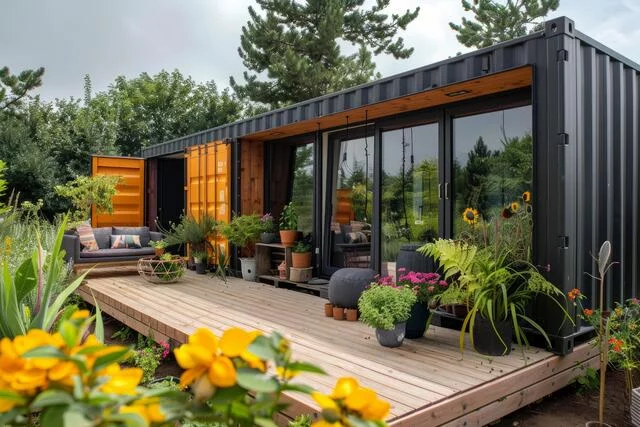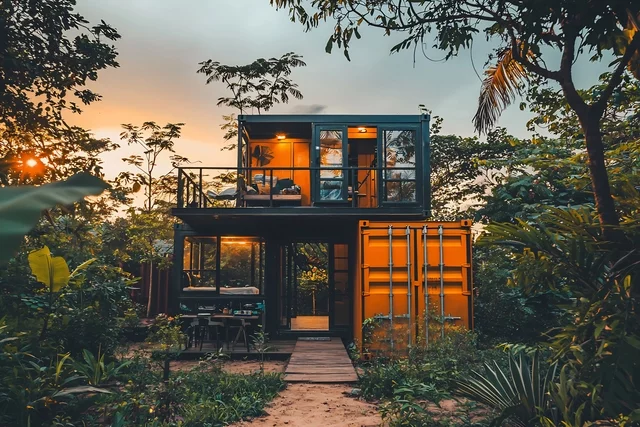
Creating a Mini Home Base with Container Homes in South Africa
Digital nomads are increasingly moving away from their transient lifestyles and seeking to establish permanent mini home bases. Container homes have become as a popular choice for these individuals, offering eco-friendly, cost-effective, and highly practical solutions. In South Africa, container homes are particularly appealing due to the affordability of materials, rapid construction timelines and adaptable designs that allow for easy customization and future expansions. These modern homes provide an ideal blend of sustainability, security, and style for those looking to settle down without losing the flexibility to grow or relocate.
Container homes are an excellent choice for many individuals looking to establish a home base. Their compact design allows homeowners to start small and expand later, adding rooms or spaces as needed to suit their changing lifestyles. The rapid construction process ensures that homes can be manufactured and delivered in just a few weeks, significantly faster than traditional builds. With durable steel construction and secure locking mechanisms, these homes offer a reliable lock-up-and-go option, perfect for individuals who travel frequently. Additionally, container homes are eco-friendly, made from upcycled materials, and feature energy-efficient designs that minimize environmental impact while promoting sustainable living.
The Benefits of Building Container Homes in South Africa
Container homes have become a popular alternative to traditional housing in South Africa, offering a range of practical and financial advantages. As people look for cost-effective, sustainable, and rapidly constructed housing solutions, these container homes are proving to be an ideal option with many container home companies starting to supply ready made solutions.
Cost-Effectiveness
One of the most appealing benefits of container homes is their affordability. These homes are typically 20–30% cheaper than conventional builds, with basic models starting at under R200,000. For homeowners on a budget, container homes provide a way to achieve quality living spaces without the high costs associated with bricks-and-mortar construction. The savings can be redirected toward interior design, energy-efficient systems, or future expansions.
Readily Available Materials
South Africa has an abundant supply of shipping containers, making procurement straightforward and cost-effective. The availability of these materials reduces shipping and sourcing costs, which can significantly impact overall project budgets. This local accessibility makes container homes not only affordable but also a practical choice for urban and rural locations alike.
Fast Construction
The speed at which container homes can be built is another major advantage. Depending on the size and design, these homes can be completed in as little as 2–10 weeks. Unlike traditional construction methods that are often delayed by weather or labor shortages, container homes are primarily manufactured off-site. Once completed, they are transported to the site, minimizing the time needed for assembly. For those in need of a quick housing solution, this rapid timeline is a significant benefit.
Minimal Environmental Disruption
Building container homes off-site also reduces the environmental impact of construction. Unlike conventional methods, which often result in significant on-site waste and debris, container homes leave little to no mess at the installation site. This approach minimizes disruption to the surrounding environment, making container homes an excellent choice for eco-conscious homeowners. Additionally, the use of upcycled materials contributes to a lower carbon footprint, aligning with global sustainability goals.
A Smart Housing Solution
Whether you’re looking to build in the city or create a tranquil rural retreat, container homes in South Africa offer a smart, efficient, and sustainable housing solution. Their affordability, availability, rapid construction, and minimal environmental impact make them a standout choice for modern homeowners seeking practicality and value.
For many people seeking a bond-free lifestyle, container homes offer a flexible and mobile housing solution. One of the significant advantages is the ease with which these homes can be relocated, fitting conveniently onto a truck for transport. This mobility allows homeowners to explore various settings across South Africa, from urban centers to remote landscapes.
Urban Settings for Container Homes
In cities like Pretoria, neighborhoods such as Hatfield and Brooklyn provide vibrant, connected living environments. These areas offer access to amenities, coworking spaces, and a community of like-minded individuals, making them attractive for digital nomads. Establishing a container home in these suburbs combines the convenience of urban living with the affordability and sustainability of container housing.
Scenic Locations for Container Homes
Just a short drive from most cities in South Africa, one can experience the serene African bushveld. Areas like Dinokeng Game Reserve or the Magaliesberg region offer picturesque environments where container homes can be nestled amidst nature. These locations provide a tranquil retreat without straying far from the city, ideal for those who value both connectivity and peace.
Remote Locations for Container Homes
For those desiring ultimate privacy and sustainability, setting up a container home on farmland or off-grid areas is an appealing option. Collaborating with landowners who have unused portions of their property can be mutually beneficial.
 However, it’s crucial to consult with town planners to navigate land use regulations and ensure compliance with local zoning laws. The Spatial Planning and Land Use Management Act governs many of these aspects of urban and rural living, and professional guidance can go a long way toward facilitating a smooth process. Engaging with town planners can help in understanding the necessary approvals and permits required for different locations. Additionally, considering access to utilities and the impact on the environment are vital steps in the planning process.
However, it’s crucial to consult with town planners to navigate land use regulations and ensure compliance with local zoning laws. The Spatial Planning and Land Use Management Act governs many of these aspects of urban and rural living, and professional guidance can go a long way toward facilitating a smooth process. Engaging with town planners can help in understanding the necessary approvals and permits required for different locations. Additionally, considering access to utilities and the impact on the environment are vital steps in the planning process.
While the mobility of container homes is certainly advantageous, it’s essential to address all the other logistical factors. The idea of setting up a container home in a remote, idyllic location is undeniably appealing or even romatic, it’s important to consider the practical realities of daily living.
Human necessities such as running water, proper sanitation, and waste management can quickly become challenges when venturing too far from established infrastructure. Septic tanks, for example, require accessibility for regular emptying and servicing, which can be costly and logistically complex in remote areas.
Makeshift arrangements, while tempting for quick fixes, can lead to serious environmental consequences, including the contamination of key water supplies that serve nearby communities and cities. This is why careful planning and consideration of local resources, regulations, and environmental impact are crucial when deciding where and how to set up a container home. A balance between the romantic notion of off-grid living and the practicalities of responsible habitation ensures a sustainable and problem-free lifestyle.
Are container homes durable enough to last long-term?
Yes, container homes are highly durable. Constructed from Corten steel, these homes are designed to endure the harsh conditions of ocean transport, making them resistant to extreme weather. With proper maintenance, such as rust prevention and periodic inspections, container homes can last over 25 years. Their robust construction also provides excellent resilience against wind, heavy rain, and minor seismic activity, ensuring they remain structurally sound over time.
How can container homes maintain comfortable temperatures year-round?
Temperature control in container homes is managed through high-quality insulation and optional external cladding. These features prevent the steel structure from retaining excessive heat or cold. Additionally, roof overhangs, solar shading, and energy-efficient windows can further enhance comfort. Modern insulation materials allow container homes to remain warm during winter and cool during summer, ensuring a pleasant living environment regardless of climate.
Do I need planning permissions for a container home?
Yes, planning permissions are often required for container homes, but the regulations vary by location. Some areas classify them as temporary structures, while others consider them permanent residences. It’s essential to consult with local authorities or town planners to understand the specific requirements in your municipality. Experts can assist with submitting applications, ensuring zoning compliance, and addressing any restrictions that may apply.
What type of foundation is required for a container home?
Container homes require a stable foundation to ensure structural integrity. Pier foundations are a common choice as they are cost-effective, quick to install, and suitable for sloped or uneven land. For softer ground or areas with higher load-bearing needs, concrete slab foundations may be more appropriate. The choice of foundation depends on site conditions and the size of the container home, and professional advice should be sought for the best solution.
Are there any challenges unique to container homes?
While container homes offer many benefits, challenges like managing legal requirements, ensuring proper insulation, and selecting the right foundation need to be addressed. Additionally, transporting and positioning the container may require specialized equipment, particularly for remote locations. However, with proper planning and the assistance of experienced professionals, these challenges can be overcome effectively.
Understanding the Reality of Container Home Design
Designing a container home offers exciting possibilities, but it also comes with unique challenges that must be addressed to ensure functionality, comfort, and sustainability. While the flexibility of these homes is appealing, homeowners should be aware of the potential issues that arrise in the design process. By understanding and preparing for these challenges, homeowners can create a container home that meets their needs, aligns with their budget, and provides a unique, sustainable living space.
Space Constraints
Shipping containers come in standardized sizes, typically 20 or 40 feet in length, which limits the available interior space. This can make it challenging to create a layout that feels open and functional, especially for larger families or those with specific space needs. Maximizing every square foot becomes essential, often requiring creative solutions such as multi-purpose furniture or vertical storage systems.
Structural Integrity
Cutting openings for windows, doors, or larger rooms can weaken the structural integrity of the container. While reinforcing the steel frame can address this issue, it adds to the overall cost and complexity of the project. Ensuring that the structural modifications are done correctly is critical to maintaining the home’s durability and safety.
Insulation and Temperature Regulation
Metal containers are prone to extreme temperature fluctuations, absorbing heat in summer and becoming cold in winter. Proper insulation is necessary to maintain comfortable living conditions year-round. However, high-quality insulation materials and techniques can significantly increase the cost of the build, making it a key consideration for budget-conscious homeowners.
Limited Layout Flexibility
The linear, rectangular shape of containers can be restrictive when it comes to layout design. Creating flowing, organic spaces or unconventional layouts may require combining multiple containers, which increases costs and complicates the construction process. Designers often need to work within these constraints to achieve functional and visually appealing results.
Planning and Zoning Regulations
Container homes are subject to the same zoning and building regulations as traditional homes. Some municipalities may not approve container homes due to aesthetic concerns or classification as temporary structures. Securing the necessary permits can be time-consuming, and working with experienced town planners is essential to navigate the legal hurdles.
Waterproofing and Moisture Control
Steel containers are susceptible to condensation, which can lead to moisture buildup and mold growth if not properly addressed. Effective waterproofing, ventilation, and moisture barriers are essential to maintain a healthy indoor environment.
Transportation and Site Access
Transporting the container to the build site requires heavy machinery and proper logistics. If the site is in a remote or hard-to-reach location, additional costs and planning may be necessary to ensure safe delivery and placement.
Noise Insulation
The metal structure of a container can amplify external noises such as rain or wind. Adequate noise insulation is necessary, particularly in areas with heavy rainfall or urban settings, to create a quiet and comfortable living space.
Weight Limitations for Add-Ons
Adding features like rooftop gardens, decks, or solar panels increases the weight on the container’s structure. Reinforcing the roof and ensuring the foundation can handle the additional load is critical to prevent structural damage.
Rust and Corrosion Prevention
Over time, steel containers are prone to rust and corrosion, especially in humid or coastal environments. Regular maintenance, protective coatings, and rust-proof paint are necessary to prolong the container’s lifespan.
Ventilation Challenges
Container homes require careful planning for proper ventilation to prevent stuffiness and ensure good air quality. Integrating ventilation systems without compromising insulation or aesthetic appeal can be a design challenge.
Utility Accessibility for Maintenance
While utilities can be integrated into a container home, ensuring they remain accessible for maintenance and repairs is often overlooked. Poorly planned installations can lead to costly and invasive modifications in the future.
Thermal Bridging
The steel frame of a container can create thermal bridges, allowing heat to transfer in and out of the home. Addressing these areas with specialized materials and design techniques is necessary to improve energy efficiency.
Resale Value Uncertainty
Container homes are still a niche market, and their resale value can be unpredictable. Buyers may have reservations due to unfamiliarity or misconceptions about container homes, making resale more challenging compared to traditional houses.
Limited Financing Options
Securing financing for container homes can be difficult, as many banks and financial institutions are unfamiliar with this housing type. Homeowners may need to explore alternative funding sources, which can complicate the budgeting process.
While social media often romanticizes the polished, off-grid tiny home lifestyle, the reality of living full-time in a container home is not always as idyllic as it seems. Challenges such as insulation, utility integration, and maintenance can complicate the experience, especially for those unprepared for the practicalities involved. However, by understanding the considerations outlined above and approaching the process with a willingness to “make a plan,” container homes can still provide a comfortable, sustainable, and uniquely rewarding living environment. With proper planning and adaptability, the dream of container living can become a manageable and fulfilling reality.
Aesthetic Challenges in Container Home Design
Container homes are celebrated for their modern appeal, but achieving a polished look requires careful planning. Without attention to design and finishing, these homes can retain an industrial feel that may not align with a homeowner’s vision.
Cladding Your Container Home
Cladding is essential to elevate the appearance of a container home. Materials such as wood, fiber cement, or composite panels can transform the steel exterior into a sleek or rustic façade. Beyond aesthetics, cladding provides added insulation and protection against the elements, enhancing both functionality and appearance.
Exterior Finishes to Add Character
Exterior finishes like paint, texture coatings, or decorative panels improve the overall look. Bright colors make a statement, while neutral tones offer timeless appeal. Overhangs, shutters, or awnings add depth and soften the industrial feel of the container.
Landscaping
Landscaping softens the edges of a container home. Garden beds, potted plants, or climbing vines create a natural contrast to the steel. Pathways, decks, and patios enhance functionality while integrating the home into its surroundings.
Windows and Doors
Strategic placement of windows and doors transforms the container’s look. Large windows or sliding glass doors break up solid steel panels and allow natural light to create an open feel. Unique shapes or materials, such as frosted glass, add personality while maintaining functionality.
Interior Aesthetics and Continuity
Interior finishes like drywall, paneling, or exposed materials should align with the exterior aesthetic. Lighting, furniture, and décor contribute to creating a cohesive, welcoming living environment.
Avoiding the “Unfinished” Look
Skipping cladding, finishes, or landscaping risks leaving the home looking too industrial. These elements are essential for ensuring the home feels like a comfortable living space rather than a repurposed shipping container.
Cost of Customisation in Container Home Design
 The level of customization chosen can significantly impact both construction timelines and costs. Many homeowners opt for containers that are at least 50% customized at the time of delivery, which can dramatically reduce construction expenses and the time needed to make the home move-in ready. This approach provides an efficient and cost-effective way to balance personalization with practicality.
The level of customization chosen can significantly impact both construction timelines and costs. Many homeowners opt for containers that are at least 50% customized at the time of delivery, which can dramatically reduce construction expenses and the time needed to make the home move-in ready. This approach provides an efficient and cost-effective way to balance personalization with practicality.
Pre-customized or “ready-to-fit” containers are designed with key features already integrated. These may include insulation, wiring, plumbing, windows, doors, and even basic interior finishes. By opting for containers that are partially or fully customized before delivery, homeowners avoid the complexities and costs of on-site modifications. These pre-customized units can be transported directly to the site and set onto pier foundations, significantly reducing labor costs and construction timelines.
Ready-to-fit containers streamline the construction process. Since much of the customization is done in a controlled factory environment, there are fewer delays caused by weather or on-site inefficiencies. The precision of factory work also reduces material waste, further cutting costs. Additionally, the simplicity of transporting pre-built containers to the site eliminates the need for large teams of contractors, making these homes an economical option.
While customization allows homeowners to personalize their space, certain features like rooftop gardens, solar panels, or luxury finishes can quickly escalate costs. Prioritizing essential customizations during the initial design phase ensures that the home remains within budget. For example, homeowners can start with basic layouts and add non-essential features like decks or additional rooms later, keeping initial costs manageable.
The efficiency of pre-customized containers also translates to shorter construction timelines. Homes can often be completed and delivered in as little as 4–10 weeks, depending on the level of customization. Once delivered, the containers are simply placed on pre-prepared pier foundations and connected to utilities, allowing homeowners to move in almost immediately.
Renting Out Your Container Home
Compact homes are quickly becoming a favorite for property owners looking to capitalize on the growing demand for unique rental spaces. With more digital nomads seeking flexible, affordable, and inspiring places to stay, container home hubs are popping up in scenic areas or tucked into quiet corners of unused land. These hubs offer short- and long-term accommodations, combining functionality with charm to attract a steady flow of renters.
Digital nomads love container homes because they offer affordable living with an eco-friendly edge. Many are set up with practical amenities, strong Wi-Fi, and cozy designs that make them perfect for work and relaxation. For property owners, container homes are a cost-effective way to turn unused space into a lucrative income source. With basic models priced under R200,000 and quick installation times, the upfront costs are far lower than traditional builds.
The durability of container homes also makes them a smart choice for rentals. Built from sturdy steel, they require less maintenance than conventional homes and are designed to last for decades with proper care. High-quality finishes and treatments prevent rust and reduce long-term upkeep costs. For property owners managing multiple units, this durability is a major advantage.
What sets container homes apart is their flexibility. They can be customized to suit almost any need, from cozy studios to two-bedroom rentals with private outdoor spaces. If the market changes, they can be relocated or repurposed with ease, making them an adaptable investment. Property owners in South Africa are already embracing the trend, creating container home hubs that offer digital nomads and vacationers a unique and sustainable place to stay.
Container homes offer a practical, affordable, and sustainable solution for digital nomads seeking a permanent base or property owners looking to diversify their rental offerings. With their low construction costs, adaptability, and minimal environmental impact, they align perfectly with the needs of modern living. In South Africa, the availability of materials, quick setup times, and potential for customization make container homes a compelling choice for those wanting to balance functionality with style. Whether as a personal retreat, a long-term residence, or a rental investment, container homes provide a smart and secure way to embrace a flexible and forward-thinking lifestyle.



